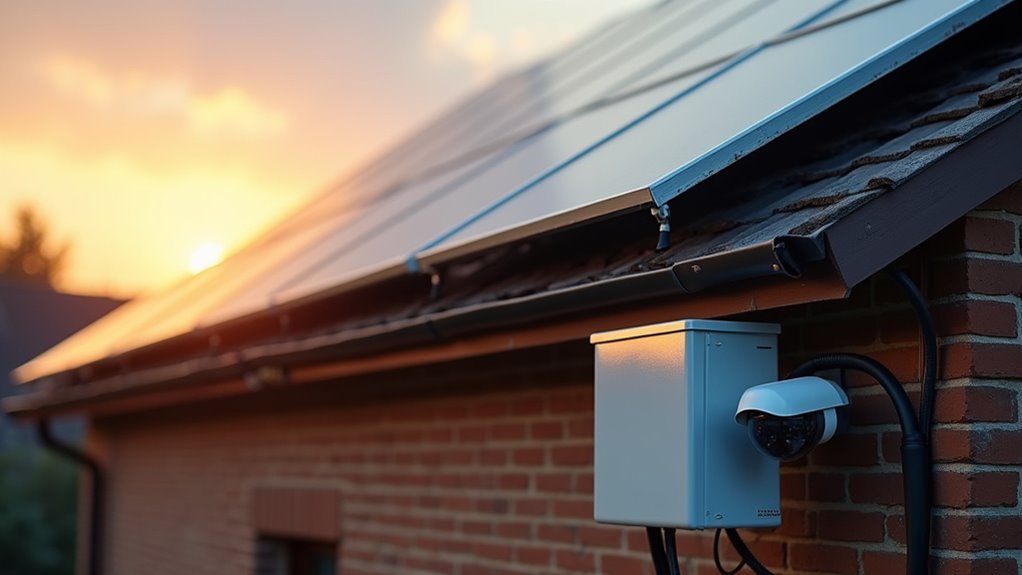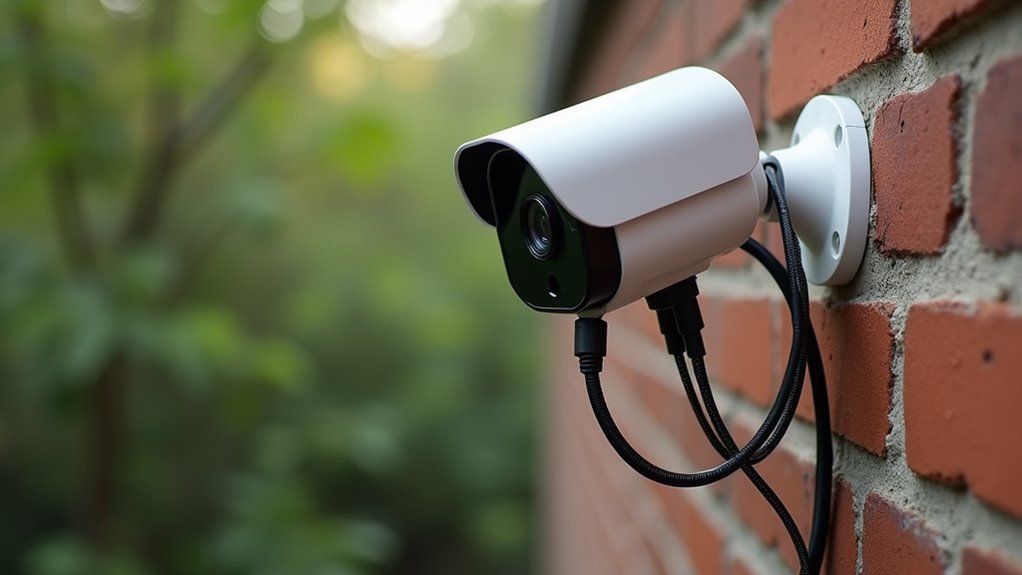You’ve invested in a smart security camera to protect your property, but you’re facing a critical challenge that could render your investment useless. Without reliable power, your camera becomes nothing more than an expensive paperweight when you need it most. Whether you’re dealing with remote locations, frequent power outages, or simply want flexibility in camera placement, the solution lies in understanding your power options and their unique advantages.
Solar Panel Systems With Battery Backup

Two 100-watt solar panels paired with a charge controller and proper wiring can effectively power multiple smart security cameras in off-grid locations.
Two 100-watt solar panels with charge controller provide reliable power for multiple smart security cameras in remote off-grid installations.
For six Wyze Cam v3 units, you’ll need 720 watt hours daily, requiring a minimum 60Ah 12V battery or 100Ah LiFePO₄ battery for ideal energy usage. Each outdoor camera consumes approximately 5 watts, totaling 30 watts for six cameras.
You’ll need 4-5 hours of good solar conditions daily to maintain your power requirement. Connect cameras directly to the battery using modified USB adapters to eliminate inverter inefficiencies.
Solar panels starting around $19.99 can keep your system operational during cloudy periods, ensuring continuous surveillance coverage without grid dependency.
Direct Battery Power Connections
Connecting your smart security cameras directly to battery power eliminates the need for inverters and greatly boosts system efficiency. Most security cameras operate on DC power, making direct battery connections straightforward using USB cables with proper modifications.
You’ll need specific adapters and fuses for safe operation. A 12V setup works better than 5V for longer distances, preventing voltage drop that reduces efficiency. Six cameras typically require about 30 watts total power.
| Component | 5V System | 12V System |
|---|---|---|
| Voltage Drop | High over distance | Minimal |
| Efficiency | Lower | Higher |
| Cable Requirements | Thicker gauge needed | Standard gauge works |
| Smart Home Integration | Standard USB | Requires step-down adapter |
This direct connection approach maximizes your battery life while maintaining reliable camera operation.
Portable Power Station Solutions

When you need maximum flexibility for camera placement, portable power stations offer an ideal solution that combines mobility with reliable performance.
These units serve as an efficient power source for your smart security cameras, particularly wireless outdoor models like the Wyze V3. You’ll appreciate the easy mobility these stations provide, allowing you to position cameras in remote locations without traditional wiring constraints.
Portable power stations eliminate wiring limitations, giving you the freedom to position security cameras anywhere you need surveillance coverage.
The built-in batteries can sustain multiple cameras simultaneously, ensuring continuous operation for extended periods. You can connect your cameras directly to the DC output, maximizing efficiency while avoiding unnecessary power conversion.
For enhanced battery life, you can integrate solar panels with your portable power station, maintaining constant charging even during overcast conditions and enabling truly flexible placement options.
Wired Electrical Installation
Although portable power stations offer excellent flexibility, wired electrical installations remain the gold standard for smart security cameras that demand unwavering reliability.
You’ll get a constant power supply that eliminates battery concerns and guarantees uninterrupted operation.
When planning your installation, you’ll need to take into account cable routing through walls, ceilings, or conduits to reach desired camera locations.
For outdoor environments, use outdoor-rated cables and weatherproof junction boxes to protect against moisture and temperature changes.
Power over Ethernet (PoE) technology simplifies your setup by combining power and data transmission through a single cable, reducing clutter.
Proper planning and secure connections are essential for peak performance.
Always follow local electrical codes during installation to promote safety and compliance with regulations.
Hybrid Power Configurations

Why settle for a single power source when you can combine the best of both worlds? Hybrid power configurations merge solar panels with battery systems, delivering reliable energy for your outdoor cameras.
You’ll achieve continuous operation even during cloudy days or nighttime hours when solar generation stops. For ideal performance, consider multiple 100W solar panels supporting several security cameras.
Six cameras typically require around 720Wh daily, so plan your power needs accordingly. A 75Ah LiFePO₄ battery provides adequate energy storage with 80% usable capacity.
Maximize efficiency by connecting cameras directly to the battery instead of using inverters that waste energy through DC-to-AC-to-DC conversion.
Your hybrid setup recharges during daylight while maintaining power for essential functions like cloud storage uploads, ensuring your security system never goes offline.
Frequently Asked Questions
What Is the Best Way to Power a Security Camera?
You’ll want wired power for continuous operation if electricity’s available nearby. If not, choose battery-powered cameras with solar panels for remote locations, ensuring you’ll get adequate daily sunlight for recharging.
What’s the Best Security Camera Without a Subscription?
You’ll find the Lorex 4K Camera offers excellent resolution with local storage, avoiding subscription fees. Eufy’s 4G Starlight Camera works without Wi-Fi, while Wyze Cam v3 provides free cloud storage for basic recording needs.
What Is Smart Mode on a Security Camera?
Smart mode uses AI to detect specific movements like people, vehicles, or pets, sending you customized alerts. You’ll get fewer false alarms and can set detection zones for targeted monitoring of areas that matter most.
How Often Do Battery-Powered Security Cameras Need to Be Charged?
You’ll need to charge your battery-powered security camera every 1 to 5 months, depending on usage, video quality settings, motion detection frequency, and environmental conditions affecting power consumption.





Leave a Reply